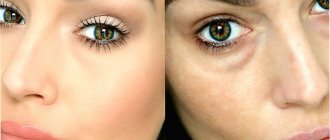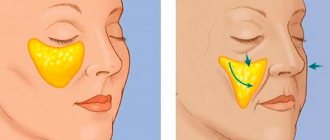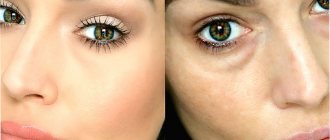Causes
If bags under the eyes appear in a newborn, this may be due to many reasons:
- Swelling. It often occurs in infants immediately after birth and usually goes away within a few weeks. Swelling is due to the fact that the child was in the womb for a long time, where all external tissues were immersed in amniotic fluid.
- Increased sensitivity of the skin around the eyes. This means that any exposure to a negative factor causes a reaction on the eyelids. The condition can also manifest itself in a rash, redness, itching, burning and other unpleasant symptoms.
- Rhesus conflict between mother and fetus. It is formed only if the mother is Rh positive and the child is Rh negative. This means that the woman’s immune system perceives the fetus as a foreign agent, and therefore secretes antigens against it. With modern therapy, pregnancy can be maintained, but the negative reaction of the immune system affects the fetus.
- Endocrine disorders. This condition is often observed with thyroid pathology. This affects the child’s appearance; he becomes swollen, especially in the eye area.
- Allergic reactions. They can be formed by the action of household allergens, for example, dust, animal hair. Or when the mother consumes foods that negatively affect the health of the baby during breastfeeding.
- Increased intracranial pressure. This is a neurological disorder that is accompanied by headaches, swelling of the facial tissues, which causes the baby to become restless.
- Kidney pathologies. When the urinary system is disrupted, fluid is retained in the body and therefore distributed among tissues and organs. Swelling appears not only on the face, but also on the limbs.
- Infectious and viral diseases that weaken the entire body. The condition is aggravated if the pathogen enters the eye tissue. Swelling, inflammation, redness and other pathological symptoms form. If an infection gets into the eyes, the condition is accompanied by suppuration of the inner corner.
Each cause has its own treatment, so the doctor needs to classify the disease and determine the exact cause.
Possible causes of occurrence in infants
Foreign object
A speck, mother's hair, eyelash or small debris may accidentally get into a newborn's eye, which will begin to mechanically irritate the mucous membrane of the eye. Most often, a foreign object is washed away naturally, with tears. But the protective mechanisms of the fiber and mucous membrane of the baby’s eye “react” for some time, this causes redness of the eye and some swelling of the eyelids. It is necessary to carefully examine whether there is anything left in the baby’s eye that is causing concern. If necessary, rinse your eyes with a gauze pad.
Injury
As soon as the grasping reflex appears, babies can damage their eyes with a rattle or any object in their hand. The baby may accidentally scratch himself or poke himself in the eye with a finger. With minor mechanical damage, the swelling will go away in just a few hours. If the injury is serious or minor debris is not found in the eye, the mucous membrane is irritated, and the swelling of the eye is pronounced, you should immediately show the baby to a pediatric ophthalmologist.
Viral diseases
Conjunctivitis is the most common eye virus in children; it is easily transmitted from other children and requires special treatment. Signs of infection - the eyelids swell, the mucous membrane of the eyelids becomes inflamed and red, the whites of the eyeball are inflamed, and red blood vessels appear. Later, greenish discharge appears from the eyes, after sleep the child cannot open his eyes, the crust around the eyes interferes.
Important: the dangerous conjunctivitis virus acts quickly and is difficult to eliminate; the dangerous conjunctivitis virus acts quickly and is difficult to eliminate
The cause of swelling of a newborn's eyelids can be any cold infection, sore throat, rhinitis, flu, acute respiratory viral infection or acute respiratory infection. Common symptoms include fever, restlessness of the baby, redness of the face, nasal discharge, and some swelling of the eyelids. There is no need to worry; swelling of the eyes in this case is one of the signs of the disease. As soon as the baby begins to recover, the swelling of the eyes will go away.
It happens that barley appears on the baby's eyelid - a small abscess. The baby's affected eyelid turns red and swells. You cannot remove the abscess yourself; this is very dangerous; the disease can become chronic.
Herpes infection also provokes redness of the eyeball, sticking and swelling of the child’s eyelids, itching and watery eyes. This requires special assistance from a doctor.
Allergy
If one of the parents suffers from allergies, the baby most often inherits this disease. Nursing mothers need to exclude all “dangerous” foods from their diet so as not to cause allergies in the baby.
During the first feedings, parents should carefully introduce fruits and berries, juices, new foods (meat, fish, etc.) into the baby’s menu (no more than 0.5 tsp) so as not to provoke allergies.
A negative reaction can be caused by any smell (flowers, houseplants, perfume, toiletries, detergents, etc.). Even a feather pillow or pets can cause an allergic reaction in an infant in some cases.
Important: detect and eliminate the source of the allergy; within a few days, the swelling in the child’s eyes will go away.
If the baby behaves restlessly, itching and redness appear, swelling of the tongue and the entire face is added to the swelling of the eyes, it is better to show the baby to a specialist - an allergist.
Unhealthy food
Nutrition of a child is the main thing in a child’s life. Only parents should control what and how the baby ate.
When breastfeeding, the mother's diet should exclude all harmful foods and drinks (coffee, alcohol, smoked foods, pickled vegetables, berries and allergenic fruits, etc.). All this can not only cause serious disorders in the infant’s fragile digestive system, but also cause allergies and edema for both mother and newborn.
Expert opinion
Kataev Alexander Igorevich
Pediatric ophthalmologist, ophthalmologist (ophthalmologist), ophthalmologist-surgeon with more than 10 years of experience.
Bags under the eyes may be an anatomical feature that your baby inherited from relatives. To see this, look at their childhood photos.
During active complementary feeding, the child should be given neutral food, not over-salted, without spices or additives. It is known that excess salt retains fluid, as a result of which the baby’s eyes may become swollen.
Attention! You should not allow your child to eat chips, crackers, processed foods and all “advertised” foods, this is very dangerous!
When visiting or on the street, you should not allow strangers to “feed” the baby. Parents need to strictly control what their child eats.
To prevent fluid retention and swelling of the eyes, the child does not need to give a lot of fluids. If a child requires more fluid than the permissible norm, he may be overheating or there is an inflammatory process in the body.
Reference. Excessive need for drinking - hydrolability - is a feature of infants under the age of 3-4 months.
Diseases
In some cases, inflamed and swollen eyes in a baby can cause serious problems in the body:
- infant's intraocular or intracranial pressure;
- inflammation in the urinary system (impaired urination, cloudy urine with an unpleasant odor, there may be blood in the urine);
- heart failure (cough, choking, bruises under the eyes, increased heart rate);
- pathologies of the liver or kidneys (fever, abdominal pain, swelling of the whole body, the baby is not gaining weight, etc.);
- hormonal disorders (loss of appetite, swelling of the body, etc.);
- infantile hypothyroidism – general mucous edema (delay in physical and psychomotor development);
- hydrocephalus (intracranial pressure, swelling of the fontanel);
- anemia, jaundice, blood diseases are caused by incompatibility with the mother's Rh factor.
Physiological characteristics (from birth)
- during childbirth, the baby passes through the birth canal, the head is compressed, blood circulation is impaired, as a result - bags under the eyes in infants (goes away by 2-3 months of life);
- genetic predisposition, if the child “gets” bags under the eyes from birth;
- when teeth are being cut, the child cries a lot, tears flow randomly, this causes slight swelling of the baby’s eyelids and inflammation in the mouth;
- overwork, oversight, inattention, non-compliance with hygiene standards are conditional physiological factors for swelling of the baby’s eyes.
Wrong mode
Swelling of a baby's eyelids may occur due to fatigue or overwork. For example, the baby could not sleep due to colic or fever that tormented him, was capricious all night, and did not get enough sleep. By morning, inflamed bags appear under the eyes. This is a natural reaction of the baby’s body to malaise and poor sleep.
Symptoms
In addition to severe swelling of the skin around the eyeballs, infants may experience additional symptoms:
- redness of the tissue on the eyelids or the eyeball itself;
- severe swelling that can completely cover the eyeball;
- discomfort in the eyes: itching, burning, pain, sensation of a foreign body that is not actually there;
- discharge of purulent contents from the eyes, which sticks the eyelashes together in the morning (with a bacterial cause of edema);
- general malaise - the child becomes whiny, irritable, cries for any reason;
- additional allergic reaction in the form of redness, peeling, itching, burning, rash.
If any of the above symptoms occur, it is recommended to consult a doctor. This will prevent the risk of many complications for the eyes and the whole body.
Diagnostics
To determine the patient's health status, the doctor performs several diagnostic tests:
- Interview with the child's parents. They may complain about disturbing symptoms and tell what diseases the mother had during pregnancy.
- General inspection. With its help, you can detect purulent discharge due to the action of bacteria, a foreign body in the eyes, allergic manifestations and many other signs.
- Bacteriological culture. With its help, the pathogens that cause the disease are detected, as well as the antibiotic to which it is sensitive.
- Serological study. This is a method to determine the viral nature of the disease.
- General clinical analysis of blood and urine, blood biochemistry. Based on these tests, cellular levels in various human biological fluids can be determined. The doctor may suspect the disease depending on the deviation from normal urine and blood parameters.
- Allergy test. It is carried out in the autumn-winter period, when the child is completely free of any types of allergies. Various groups of antigens are sequentially applied to the child’s wrist. If redness or inflammation appears in any part of the hand, this indicates an allergic reaction to the substance applied by the doctor.
Based on diagnostic tests, the doctor can make a reliable diagnosis, only then treatment begins.
Regulating your baby's drinking regime
If your baby has swelling in the eyes and other areas of the body, the doctor may advise you to stay hydrated. Typically, the amount of fluid consumed is calculated at the rate of 50 ml of water for every kilogram of the child’s body. This is the daily norm.
It is important for parents to remember that during edema, it is impossible to sharply limit the baby’s drinking. This can lead to dehydration and increased body temperature. The child should definitely be given water, but you can limit the amount.
Komarovsky about bags under the eyes of infants
In his program, Dr. Komarovsky talks about bags under the eyes of babies. He says that this phenomenon occurs in all children immediately after birth. The swelling should gradually decrease, and 2 weeks after birth it will completely disappear.
If swelling persists after this time, you should consult a pediatrician and specialist doctors. Perhaps the symptom is caused by a disease of the internal organs. If it is detected early and treatment is started, in most cases the prognosis will be favorable.
If there is prolonged swelling, you should adhere to the drinking regime for infants. If the baby is only breastfed, the amount of milk consumed is not limited. This is because it is not considered a liquid as it curdles inside the baby's stomach.
What diseases can bags be a symptom of?
When there are no prerequisites for the appearance of bags under the baby’s eyes, it is necessary to exclude the possibility of pathological changes in the body. Swelling is a sign of many diseases, so other symptoms are taken into account when making a diagnosis.
You should immediately decide what nature the swelling is - local or general. This is not difficult to do: lightly squeeze the child’s arm or leg and see how quickly the skin returns to its original position. If this takes some time, and the tissues have the consistency of dough to the touch, then the whole body is swelling, which is evidence of a violation of the functionality of the internal organs.
Problems of the cardiac system manifest themselves with the following additional signs:
- difficulty breathing;
- increased fatigue;
- increased swelling in the evenings.
The second most popular diseases characterized by swelling are kidney pathologies: glomerulonephritis and pyelonephritis. Kidney inflammation, in addition to bags, is accompanied by:
- problematic urination;
- headache;
- change in the shade of urine (sometimes there are inclusions of blood in it);
- lumbar pain;
- increased temperature;
- hypertension.
Regular swelling of the eyes in children under one year of age may indicate increased intracranial pressure. Pathology can be suspected by the baby's excessive tearfulness.
If the bags under the eyes grow gradually (over several days), are combined with pain in the frontal area or eyes and fever, the child probably has a nasopharyngeal disease. The most common:
- sinusitis;
- ethmoiditis;
- sinusitis.
Conjunctivitis of various natures is accompanied by:
- cutting pain in the eyeballs;
- tearfulness;
- itching and soreness of the eyelids;
- deterioration of vision.
Attention: An ambulance must be called if the bags have formed suddenly and are combined with restless behavior, nasal discharge, lacrimation and redness in the eyes - these are symptoms of a life-threatening condition, allergic Quincke's edema!
Endocrine diseases and metabolic disorders have the following additional symptoms:
- bowel disorders (constipation or diarrhea);
- unreasonable sudden weight gain;
- dry skin;
- weakness;
- brittle hair and nails.
Extensive swelling, severe pain in the head, cough and nosebleeds suggest the presence of cancer.
Prevention
If puffiness and bags under the eyes are caused by physiological factors, it is impossible to prevent them. All babies experience swelling around the eyes immediately after birth. To prevent pathological factors, parents should use the following rules:
- maintaining a drinking regime, using water for the baby only when necessary;
- a healthy lifestyle for the mother during pregnancy, no use of harmful, toxic substances, illegal drugs;
- compliance with all hygiene rules when caring for a baby, for example, daily cleaning of the bathtub before bathing, maintaining cleanliness and order in the crib;
- timely treatment of all systemic diseases;
- timely visits to doctors of a narrow specialty to prevent the development of ophthalmological pathologies and other diseases;
- modern therapy of local diseases in the eye area.
The presence of bags under the eyes of a newborn does not always indicate a pathological condition of the body. To make a diagnosis, additional symptoms are needed that parents can warn about or that are detected during examination. If bags under the eyes are caused by an ophthalmological disease, it is necessary to carry out complex therapy so as not to cause a risk of relapse.
Prevention of occurrence
- Healthy, long sleep for a baby (up to 10 hours) is a sign of health and well-being. A baby's eyes become swollen from lack of sleep.
- Proper nutrition and regimen, regular air baths stabilize the body's functioning.
- The air in the room where the baby lives should be clean and fresh; dry air and too high a temperature in the room should be avoided. Important: the permissible air temperature in the room is 19-20 ° C; air humidity – 50-70%.
- Clothing should be appropriate for the weather and temperature. Overheating leads to disruption of body thermoregulation; the baby drinks a lot, fluid accumulates, and therefore unwanted swelling of the eyes occurs.
- The baby’s nutrition should be complete, without “excesses”; food should not be added with additional salt, much less use seasonings that cause excess water consumption.
- For prevention, every morning the child needs to wipe his eyes with herbal decoctions or simply boiled water. After swimming, to avoid stagnation of water, your eyes should be wiped dry.
If swelling of the baby’s eyes is a one-time, non-permanent phenomenon, and the baby feels great, then you should not sound the alarm prematurely. You need to calm down and analyze what caused this reaction. Parental “instinct” and the deterioration of the baby’s condition will definitely tell you when swollen eyes are a sign of a serious illness. In this case, emergency qualified medical assistance is required.
Author of the article
Internet journalist, translator
If you find an error, please select a piece of text and press Ctrl+Enter.
Source
Bags under the eyes in healthy babies
Most often, the eyelids of babies swell due to the accumulation of intercellular fluid around the eyes. Such swellings can appear in completely healthy children for several reasons:
- Physiological edema in infants
As the baby passes through the birth canal, pressure is placed on his head. Because of this, blood circulation is disrupted for some time (which is absolutely normal), and the newborn’s eyelids swell. Such swelling is not accompanied by other symptoms and goes away on its own by about three months.
- Genetic predisposition
Bags under the eyes may be an anatomical feature that your baby inherited from relatives. To see this, look at their childhood photos.
- Poor nutrition
Bags under the eyes also appear from an excess of salt in the body. If your baby is breastfed, adjust your diet. It should not contain smoked meats, pickled foods or over-salted dishes. If you have started complementary feeding, do not add salt to baby cereals and purees.
- Wrong mode
Babies' eyelids may swell due to overwork. Poor sleep, eye strain while watching TV or playing on a tablet, reading and drawing in dim light lead to fatigue and the appearance of reddish bags under the eyes.
- Cry
Babies' eyelids swell after long bouts of crying.
Bags under the eyes are a symptom of the disease
In some cases, swollen eyelids can be a sign of pathology:
- Inflammatory processes
Sometimes bags under the eyes can appear due to inflammation: conjunctivitis, stye, herpes, etc. In this case, swelling of the eyelid is accompanied by redness of the eyeball, high fever, itching and burning (the baby scratches his eyes), sticking of the eyelids, and lacrimation.
- Viral diseases
During colds, flu and other infections, fluid can accumulate in the eye area. In itself, such swelling does not pose a danger to the child and goes away after some time after recovery.
- Problems with internal organs
Bags under the eyes may indicate inflammation of the kidneys or liver, problems with the digestive and cardiovascular systems. If your baby's eyelids swell during sleep, and when he is awake the swelling subsides, if the baby urinates rarely or too frequently, and the urine itself becomes dark or cloudy, most likely his kidneys hurt. If your baby starts having problems with stool (constipation, diarrhea, mucus in the stool), we are talking about an intestinal disorder. If the baby has shortness of breath, he gets tired quickly and a coating has formed on his tongue, perhaps the baby has heart problems. In order to identify the exact cause, the child needs to be shown to a doctor.
- Hypothyroidism
This is a disease of the thyroid gland. Bags under the eyes are one of its striking symptoms. As well as lethargy, decreased muscle tone, prolonged infantile jaundice (the skin remains yellowish for more than a month after birth), poor appetite, noisy and difficult breathing. Hypothyroidism is dangerous for children because it leads to delays in mental and physical development. To exclude this diagnosis, you need to contact an endocrinologist and get tested.
- Anemia
Sometimes redness and swelling of the eyelids, as well as dark circles under the eyes, are a symptom of anemia, that is, low levels of hemoglobin in the blood.
- Allergic reaction
Swelling of the eyelids is often accompanied by allergies to food, formula or composition of mother's milk, dust, household chemicals, medications and much more. If bags under the eyes are accompanied by swelling of the face and tongue, a barking cough and hoarse breathing, you should urgently call an ambulance. This could be Quincke's edema.









